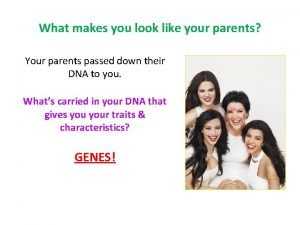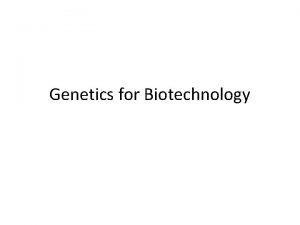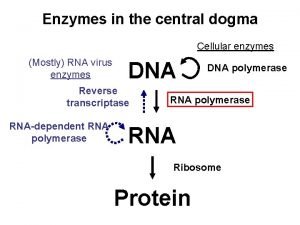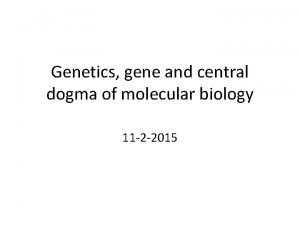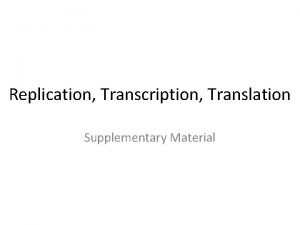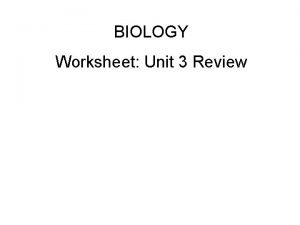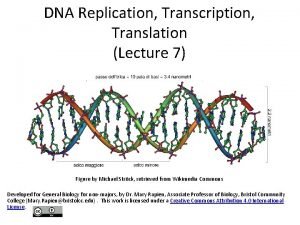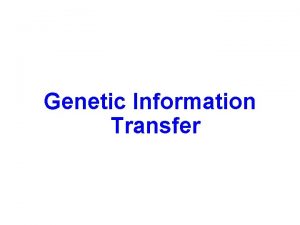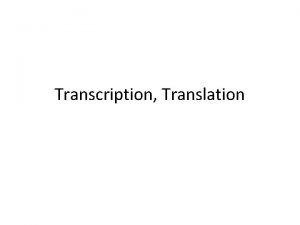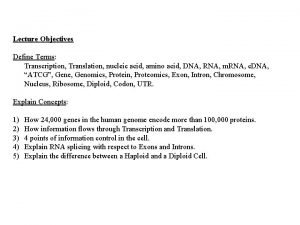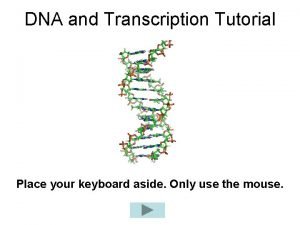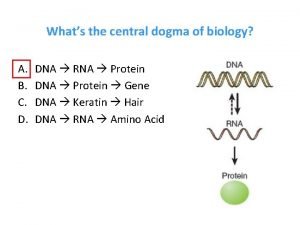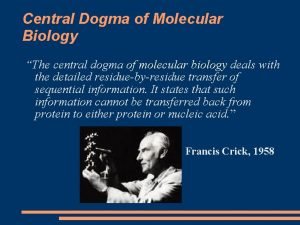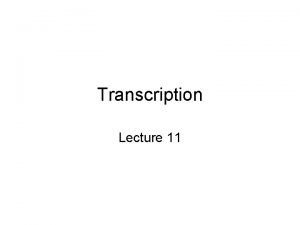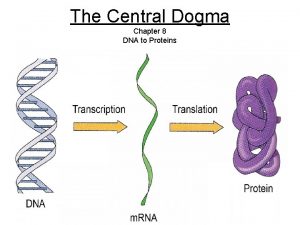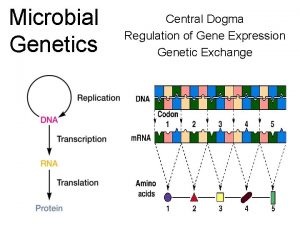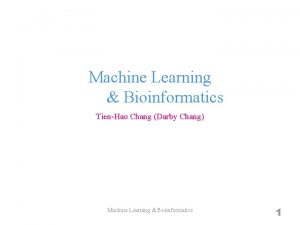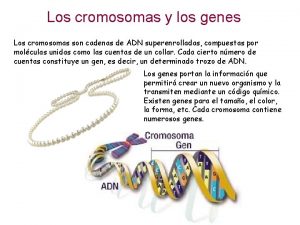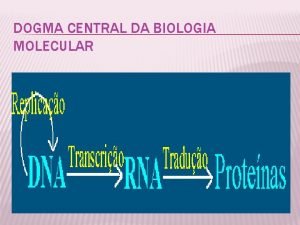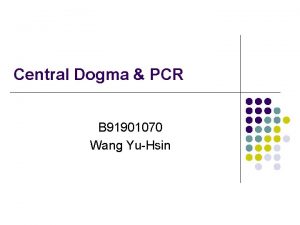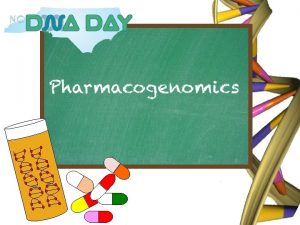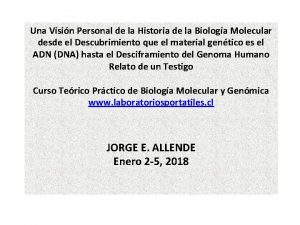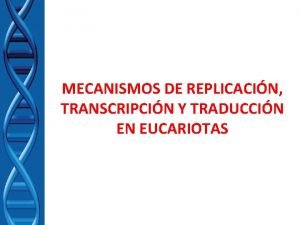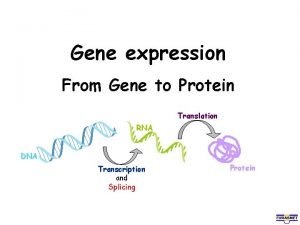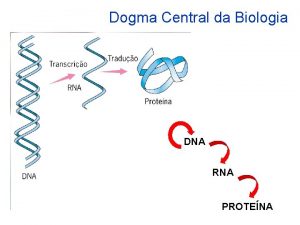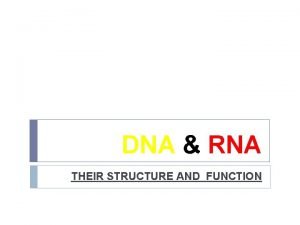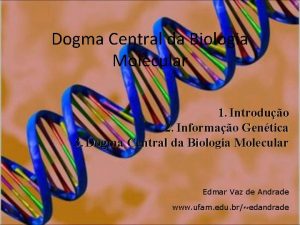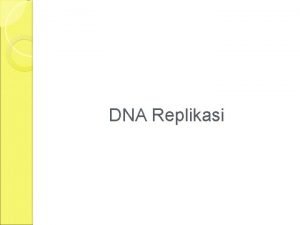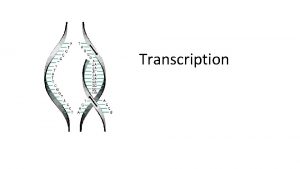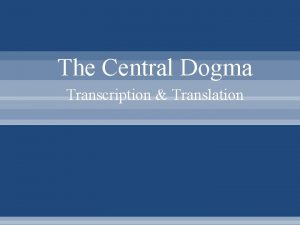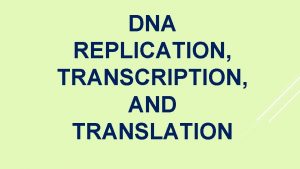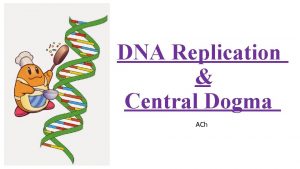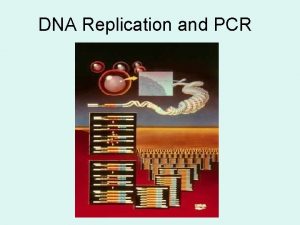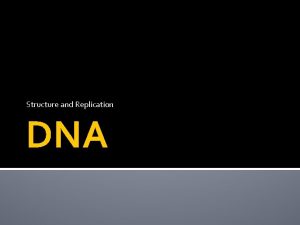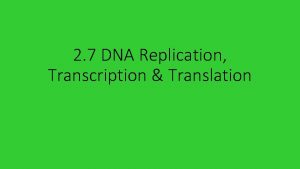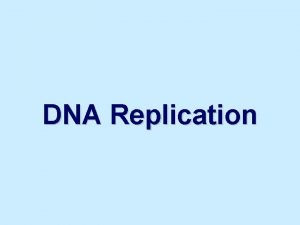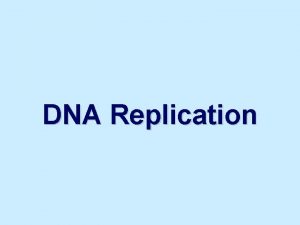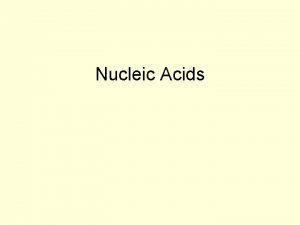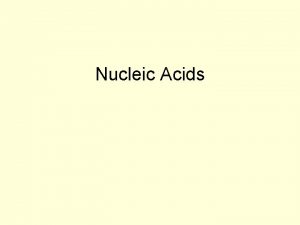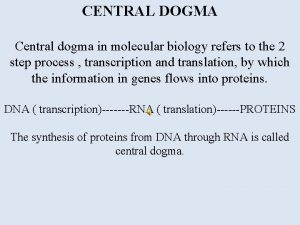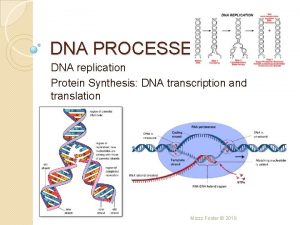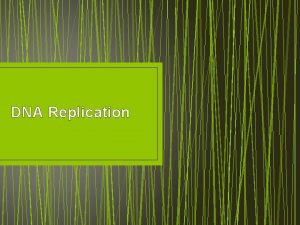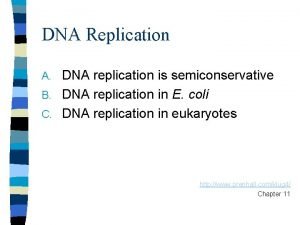Introduction to Central Dogma DNA Replication Transcription and































- Slides: 31

Introduction to Central Dogma: DNA Replication, Transcription and Translation

What is Central Dogma? • It is the flow of genetic information from DNA to Proteins Transcription DNA m. RNA Replication DNA Translation Proteins

What is DNA? • It is the fascinating molecule that contains the Code of Life.

What Is the Code of Life? • It is the Genetic Code, which is the set of “messages” that are “translated” by ribosomes into proteins that define YOU

Structure of Nucleic Acids • Recall that DNA and RNA belong to the class of biomolecules called Nucleic Acids, which are made up of nucleotide monomers

Structure of Nucleotides § The nucleotide subunits consist of: 3. A Phosphate Group 1. A Nitrogen Base 2. A Sugar (either Deoxyribose or Ribose)

Nitrogen Bases Can Be: Adenine A Guanine G Cytosine C Thymine (only DNA) T Uracil (only RNA) U

Chargaff’s Rule of Base Pairing § Erwin Chargaff analyzed DNA from different organisms and found that A=T & G=C According to Chargaff, in DNA: A always bonds with T G always bonds with C

The Sugar Group Can Be Either: Deoxyribose (in DNA) or. Ribose (in RNA) Image by: Riedell

Purines & Pyrimidines § Purines consist of Adenine § § and Guanine bases; they are double-ring structures Pyrimidines consist of Thymine and Guanine bases; they are single-ring structures A Purine ALWAYS bonds with a Pyrimidine…. A with T and G with C

Nitrogen Base Difference DNA & RNA DNA has no URACIL RNA has no THYMINE

Bonding in DNA • The nitrogen bases are held together by weak hydrogen Covalent bonds Phosphodiester Bonds • The sugar and phosphate groups are held together by strong covalent phosphodiester bonds

DNA Replication (occurs in the nucleus) Semi-Conservative: • Strand separation, followed by copying of each strand. • Each separated strand acts as a template for the synthesis of a new complementary strand.

DNA Replication (occurs in the nucleus) Step 1: • Unwinding of the double helix Ø Helicase enzyme unwinds the double helix & creates a replication fork

DNA Replication (occurs in the nucleus) Step 2: • One DNA strand is used as a template to create the new copy DNA A G C A A – – – T C G T T etc

DNA Transcription (occurs in the nucleus) • Transcription produces genetic messages in the form of m. RNA DNA Template

DNA Transcription (occurs in the nucleus) • STEP 1: As in replication, the DNA m. RNA double helix unzips • STEP 2: RNA nucleotides line up along one strand of DNA, following the base-pairing rules DNA Template

DNA Transcription (occurs in the nucleus) • STEP 3: DNA is transcribed into RNA DNA m. RNA G C T A A U G G G C T A m. RNA DNA Template

DNA Transcription (occurs in the nucleus) • Single-stranded m. RNA peels away from DNA and prepares to move into the cytoplasm DNA Nucleus m. RNA Cytoplasm

DNA Transcription (occurs in the nucleus) • Eukaryotic RNA is processed before leaving the nucleus Ø The non-coding segments, called introns, are spliced out Ø A cap & tail are added to the ends Exon Intron Exon DNA Cap RNA transcript with cap and tail Transcription Addition of cap and tail Introns removed Tail Exons spliced together m. RNA Coding sequence NUCLEUS CYTOPLASM

DNA Translation (occurs in the cytoplasm) • m. RNA leaves the nucleus and moves into the cytoplasm where it will be “translated” into a polypeptide (a fancy word for a protein) TRANSCRIPTION NUCLEUS TRANSLATION PROTEIN CYTOPLASM

DNA Translation (occurs in the cytoplasm) • • The words that will be translated are triplets of m. RNA bases called codons The codons in a gene determine the amino acids in the polypeptide sequence DNA molecule Gene 3 Gene 1 Gene 2 DNA strand TRANSCRIPTION RNA Codon TRANSLATION Polypeptide Amino acid Codon

DNA Translation (occurs in the cytoplasm) • • In the cytoplasm, a ribosome attaches to the m. RNA A t. RNA pairs with each codon, adding an amino acid to the growing polypeptide

m. RNA Genetic Code Chart Second Base C U UUC UUA UUG C CUU CUC CUA CUG A AUU AUC ile AUA AUG met (start) ACU ACC ACA ACG G GUU GUC GUA GUG GCU GCC GCA GCG phe leu val UCU UCC UCA UCG CCU CCC CCA CCG A ser UAU UAC UAA UAG pro CAU CAC CAA CAG thr AAU AAC AAA AAG ala GAU GAC GAA GAG G tyr stop his gln asn lys asp glu UGU UGC UGA UGG CGU CGC CGA CGG AGU AGC AGA AGG GGU GGC GGA GGG cys stop trp arg ser arg gly U C A G Third Base First Base U

Table 14. 2 Types of RNA Type of RNA Functions in Messenger RNA (m. RNA) Nucleus, migrates to ribosomes in cytoplasm Transfer RNA (t. RNA) Cytoplasm Provides linkage between m. RNA and amino acids; transfers amino acids to ribosomes Ribosomal RNA (r. RNA) Cytoplasm Structural component of ribosomes Function Carries DNA sequence information to ribosomes

Mutations • Mutations are changes in the DNA base sequence Ø Are caused by errors in DNA replication Ø Are caused by environmental factors, such as exposure to radiation and chemicals or temperature changes • Mutations most likely cause altered proteins to be produced • 2 Kinds of Mutations: Gene Mutations & Chromosomal Mutations

Gene Mutations • Point mutations – changes of a single DNA nucleotide – can cause sickle-cell anemia and many other disorders Normal hemoglobin DNA m. RNA Mutant hemoglobin DNA m. RNA Normal hemoglobin Sickle-cell hemoglobin Glu Val

Gene Mutations • Types of Point mutations Ø Substitutions Ø Insertions Ø Deletions

Gene Mutations NORMAL GENE m. RNA Protein Met Lys Phe Gly Ala Lys Phe Ser Ala BASE SUBSTITUTION Met Missing BASE DELETION Met Lys Copyright © 2003 Pearson Education, Inc. publishing as Benjamin Cummings Leu Ala His

Chromosomal Mutations Deletion Homologous chromosomes Duplication Inversion Reciprocal translocation Non-homologous chromosomes Copyright © 2003 Pearson Education, Inc. publishing as Benjamin Cummings

Chromosomal Mutations • Human karyotype showing addition of 1 chromosome on autosome 21 – Down Syndrome Chromosome painting
 Bioflix activity dna replication dna replication diagram
Bioflix activity dna replication dna replication diagram Dna replication transcription and translation
Dna replication transcription and translation Dna rna protein central dogma
Dna rna protein central dogma Central dogma
Central dogma Enzymes involved in central dogma
Enzymes involved in central dogma Central dogma
Central dogma Function of dna polymerase 3
Function of dna polymerase 3 Dna rna protein synthesis homework #2 dna replication
Dna rna protein synthesis homework #2 dna replication Transcription translation replication
Transcription translation replication Blood type chart
Blood type chart Venn diagram dna and rna
Venn diagram dna and rna Translation
Translation Replication transcription translation
Replication transcription translation Transcription and translation coloring
Transcription and translation coloring Dna transcription and translation
Dna transcription and translation Dna and transcription tutorial
Dna and transcription tutorial Whats that
Whats that Whats the central dogma of biology
Whats the central dogma of biology Central dogma
Central dogma Central dogma
Central dogma Central dogma cartoon
Central dogma cartoon Central dogma
Central dogma Dogma central
Dogma central Dogma central
Dogma central Central dogma
Central dogma Antidepressant side effects
Antidepressant side effects Polirribosomas
Polirribosomas Que es el dogma central de la biologia
Que es el dogma central de la biologia Central dogma of biology
Central dogma of biology Dogma central
Dogma central Central dogma diagram
Central dogma diagram Dogma central da biologia
Dogma central da biologia


